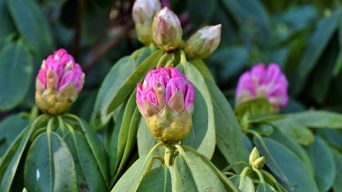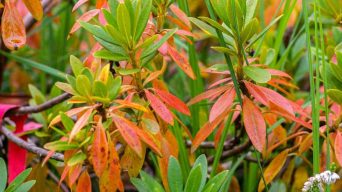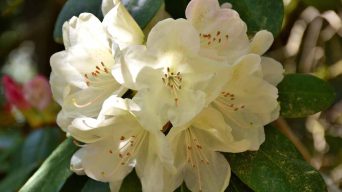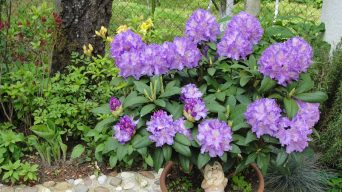Key Takeaways
- Rhododendron transplant shock occurs when plants experience stress from being moved to a new location, causing symptoms like wilting leaves, yellowing, and leaf curling.
- Causes of rhododendron transplant shock include root damage during transplantation, improper planting techniques like over-fertilizing or adding too many amendments, and environmental stressors such as extreme temperatures or wind exposure.
- To prevent rhododendron transplant shock, select the right time for transplanting (ideally during the dormant season), prepare the soil properly by testing pH levels and ensuring good drainage, use optimal planting techniques like mixing in organic matter, and acclimate the plant gradually to its new environment.
- Remedies for rhododendron transplant shock include proper watering techniques (avoid overwatering), root stimulators, and fertilizers high in phosphorous and potassium but low in nitrogen content. Prune dead or damaged branches regularly to promote new growth.
Rhododendron transplant shock is a common issue many plant owners face when relocating these beautiful flowering shrubs from one location to another.
Although it cannot be cured entirely, there are numerous steps you can take to help your beloved plants recover more quickly and continue to thrive.
In this blog post, we will dive into the symptoms, causes, and remedies of rhododendron transplant shock while providing expert tips for proper care after transplantation.
By understanding how to prevent and treat this condition effectively, you can ensure that your rhododendrons maintain their vibrant appearance and bloom beautifully in their new surroundings.
Understanding Rhododendron Transplant Shock
Rhododendrons may undergo transplant shock when moved to a new location.
This can cause stress, resulting in wilted leaves, yellowing, and leaf curling.
What Is Transplant Shock
Transplant shock is a common phenomenon experienced by plants and trees when they are uprooted from their original location and placed in a new environment.
The transplanting process can cause stress to the plant, which may result in symptoms such as wilting, yellowing leaves, stunted growth, or even death.
For example, imagine you have lovingly cared for your rhododendron plant for years in your garden but now need to move it to another spot within your garden or perhaps relocate it entirely due to changes in landscape design or other reasons.
When making this shift, if not done diligently with proper precautions and care measures taken throughout the process, there’s a high chance that transplant shock might occur.
Symptoms And Signs Of Transplant Shock In Rhododendrons
Rhododendron transplant shock can be identified by observing plant appearance changes and overall health.
Being aware of these symptoms is crucial for plant owners, as it allows them to act timely and potentially minimize any long-term damage to their rhododendrons.
The following are some common symptoms and signs of transplant shock in rhododendrons:
- Wilting leaves: One of the first noticeable signs, leaves may begin drooping or appear limp.
- Yellowing leaves: Leaves may gradually start losing their green color, turning yellow or pale.
- Leaf rolling or curling: Distorted leaf shapes can indicate stress caused by transplanting.
- Dying branches: Transplant shock may cause branches to wither and die off, mainly if root damage has occurred.
- Slow or stunted growth: Rhododendrons experiencing transplant shock may take longer to recover and produce new growth.
- Fungal leaf-spotting (Ovulinia azaleae): Often a symptom of transplant shock in rhododendrons and azaleas, leaves develop dark spots with yellow halos surrounding them.
- Root rot (phytophthora cinnamomi): A weakened or damaged root system due to transplant shock increases vulnerability to fungal infections that cause root rot.
- Aphids and weevils: Pests like aphids and weevils are likelier to infest plants suffering from stress, such as those experiencing transplant shock.
Identifying The Causes Of Rhododendron Transplant Shock
Rhododendrons may experience transplant shock due to root damage, improper planting methods, or environmental stressors.
Root Damage During Transplanting
Transplanting rhododendrons can be a delicate process, as root damage is one of the leading causes of transplant shock.
Handling the roots with care is essential during the relocation process to avoid breaking or tearing them.
To minimize root injury during transplantation, gently remove any soil surrounding the rhododendron’s root ball while carefully preserving the feeder roots.
Use proper tools, such as a spade or shovel, to dig around the plant without severely damaging its delicate root system.
Improper Planting Techniques
Improper planting techniques are one of the leading causes of rhododendron transplant shock.
Often, gardeners make the mistake of planting their new rhododendron too deep or too shallow in the ground, damaging the plant’s root system and impeding its ability to absorb nutrients.
Another common mistake is adding too much fertilizer or organic matter when planting a new rhododendron.
While some may think this can help boost growth, over-fertilizing or using too many amendments can harm delicate young plants by creating an imbalance of nutrients and disrupting ideal soil pH levels.
Environmental Stressors
One of the causes that can lead to rhododendron transplant shock is environmental stressors.
These stressors include extreme temperatures, wind exposure, and insufficient soil nutrients.
The lack of proper care before and after transplanting can intensify these stressors and damage your plant’s roots. For example, if you attempt to transplant during a hot summer day, your plant may face extra hardship due to drought-like conditions in the soil around its root ball.
Similarly, planting without sufficient organic matter or nutrients for optimal growth makes it harder for the rhododendron to thrive in its new environment.
Preventing Rhododendron Transplant Shock
To avoid rhododendron transplant shock, select the proper time for transplantation, prepare the soil correctly, utilize the best planting methods, and acclimate the plant gradually to its new surroundings.
Selecting The Right Time For Transplanting
Choosing the right time for transplanting your rhododendrons is crucial to minimizing transplant shock. The best time to do this is during the dormant season, which occurs in late fall or early spring, depending on your location.
During this period, the plant’s growth slows down, and it becomes less vulnerable to stressors associated with transplantation.
It’s important to note that evergreen shrubs like rhododendrons have different needs from deciduous shrubs for transplanting.
Evergreens should be transplanted earlier than deciduous plants because they tend to experience more water stress in hot weather due to their shallow root systems.
Preparing The Soil Properly
Proper soil preparation is essential to reduce the risk of transplant shock and ensure the success of your rhododendron transplant.
Here are some tips for preparing the soil properly:
- Test Your Soil: Conduct a soil test to determine if it’s acidic enough for rhododendrons. These plants thrive in well-drained, acidic soil with a pH between 4.5 and 6.0.
- Add Organic Matter: Mix peat moss or leaf mold into the soil to increase acidity and improve drainage.
- Check Soil Drainage: Ensure the soil drains well, as wet or poorly drained soils will cause root rot and other diseases.
- Prepare The Planting Hole: Dig a hole twice as wide as but no deeper than the root ball of your rhododendron plant.
- Amend Soil At The Bottom Of The Hole: Mix compost or aged manure into the bottom of the planting hole, then add a layer of pine needles on top to help retain moisture around the roots.
- Water Well Before Planting: Soak the plant roots thoroughly before placing it in the prepared hole, then backfill with the amended soil mixture.
By following these simple steps, you can help ensure that your rhododendron has a healthy start after transplanting and minimize the risk of transplant shock.
Using Optimal Planting Techniques
Using optimal planting techniques to prevent transplant shock in rhododendrons is important.
Here are some tips:
- Dig a hole twice as wide and deep as the plant’s root ball.
- Mix organic matter such as peat moss or compost into the soil to improve drainage and soil quality.
- Ensure the plant will be planted at the same depth as it grew before transplantation.
- Gently remove any burlap or wire from the root ball before planting.
- Backfill the hole with soil, gently pressing down on the soil to eliminate air pockets while being careful not to compact it too much.
- Water thoroughly after planting to ensure proper hydration of your newly transplanted rhododendron plant.
Remember, proper care and attention in the early stages after transplantation is essential for ensuring healthy growth in your rhododendron plants.
Acclimating The Plant To Its New Environment
Once you have successfully transplanted your rhododendrons, it’s important to gradually acclimate them to their new environment.
This process entails slowly exposing the plant to its new surroundings so as not to shock its system.
You can do this by covering the plant with a light shade cloth or providing partial shade for a few days after transplanting.
Another way of acclimating a plant is by allowing it time and space where necessary.
Rhododendrons need considerable root space, especially if they are mature plants.
You should consider planting them in locations that receive dappled sunlight or under trees whose branches provide natural shading during hot summer.
This depends on the species of rhododendron you’re growing; for example, deciduous shrubs prefer more sun than evergreen shrubs.
Remedies And Treatments For Rhododendron Transplant Shock
If your rhododendron is experiencing transplant shock, there are several ways to help it recover.
You can use proper watering techniques, root stimulators, and fertilizers, provide shade and shelter, and treat the soil with organic matter or rooting hormone.
These methods can effectively alleviate the symptoms of transplant shock.
Proper Watering Techniques
Proper watering techniques are crucial in preventing rhododendron transplant shock.
Here are some tips to keep in mind:
- Water the plant thoroughly immediately after transplanting to help settle the soil and promote new feeder roots.
- Check the soil moisture regularly, especially during the first few days after transplanting, to ensure it stays evenly moist but not waterlogged.
- Avoid over-watering, which can lead to root rot and other fungal infections. Instead, water deeply but infrequently, allowing the soil to dry slightly between waterings.
- Use a soaker hose or drip irrigation system to provide slow, consistent moisture to the root zone without wetting the leaves or causing runoff.
- Consider adding a layer of organic mulch around the base of the plant (but not touching it) to help retain moisture and regulate soil temperature.
Fertilizing And Pruning Guidelines
Following proper fertilizing and pruning guidelines is essential to help alleviate transplant shock in your rhododendrons.
Here are some tips:
- Fertilize with acid-forming fertilizer: Use a balanced, slow-release fertilizer high in phosphorous and potassium. Avoid using fertilizers high in nitrogen, as this can favor disease growth. Apply the fertilizer during the growing season, ideally after the flowering.
- Prune dead or damaged branches: Prune dead or damaged branches and leaves in the spring to promote new growth and overall health of the plant. Be sure not to prune too much, as this can lead to stress.
- Trim back one-third of mature plants: Trimming back about one-third of mature plants can help soothe shocked plants.
- Use sharp pruning tools: When pruning, be sure to use sharp pruning tools to avoid tearing branches and causing damage to the plant.
- Follow species-specific guidelines: It’s important to research species-specific guidelines for proper fertilization and pruning techniques, as different species may have different requirements.
Use Of Root Stimulators
Root stimulators are an excellent tool for helping rhododendrons recover from transplant shock.
These products contain hormones that help encourage root growth and development, speeding up the recovery process.
One popular type of root stimulator is mycorrhizal fungi, which form a beneficial relationship with your plant’s roots. It helps increase nutrient uptake and overall plant health, making it an excellent choice for stressed plants.
Another option is compost tea, which provides plenty of nutrients and promotes healthy soil microbiology.
Providing Shade And Shelter
Rhododendrons are sensitive to environmental changes, and exposure to harsh sunlight or wind can exacerbate transplant shock.
Providing shade and shelter for your rhododendron during the first few weeks after planting is crucial to help them recover from transplant shock.
You can create natural shade by planting your rhododendron under tall trees or shrubs that provide some overhead cover.
It’s important to remember that even with proper care, a transplanted rhododendron may still experience some stress during its recovery period.
By providing some extra protection from sun and wind, however, you’ll give your plant the best possible chance of thriving in its new home.
Soil And Rooting Hormone Treatments
Soil and rooting hormone treatments are effective remedies for rhododendron transplant shock.
Adding organic matter, such as peat moss or pine needles, to the planting hole can improve soil drainage while providing vital nutrients.
Additionally, using a rooting hormone when transplanting can stimulate root growth and reduce stress on the plant.
It’s important to note that these treatments should be used in moderation since over-fertilization can harm your plant’s health.
Also, it’s crucial to avoid disturbing the roots during application since further damage may cause additional stress to an already weakened plant.
Tips For Caring For Rhododendrons After Transplanting
Here are some helpful tips for treating your rhododendrons after transplanting them.
Regular Watering And Fertilizing
Proper watering and fertilizing are crucial for caring for rhododendrons after transplanting and preventing transplant shock.
Here are some essential tips to ensure your plants receive the necessary water and nutrients:
- Water your newly transplanted rhododendron regularly to keep the soil moist but not soaking wet. Aim to water deeply once a week during the growing season.
- Check the soil regularly to ensure it’s not too dry or overly saturated. You can do this by sticking your finger about an inch into the soil; it’s time to water if it feels dry.
- Fertilize your rhododendrons sparingly, using a slow-release or granular fertilizer in early spring. If you notice signs of nutrient deficiency, such as yellowing leaves, consider adding supplemental fertilizer according to the package instructions.
- Avoid fertilizing plants stressed by drought during the summer; instead, focus on providing adequate water and wait until fall to feed them again.
- Incorporate organic matter like peat moss into your planting hole when transplanting your rhododendron to help retain moisture and improve soil fertility.
Proper Pruning Practices
Pruning is an essential part of caring for rhododendrons after transplanting.
Proper pruning practices can help the plant establish and regrow its root system.
Here are some tips for pruning your rhododendron:
- Wait until after the flowering season: Prune your rhododendron to avoid removing potential flower buds after it has bloomed.
- Start with dead or damaged branches: Begin by removing any dead or diseased branches using clean, sharp pruning shears.
- Remove crossing branches: Remove branches that cross over each other as they can rub against one another and cause damage.
- Maintain its natural shape: Avoid cutting back too much on healthy branches, which can distort the plant’s natural shape.
- Cut back to one-third of mature plants: To help your rhododendron establish its new root system, cut back to one-third of mature plants.
- Use proper technique: Make sure to use the appropriate cutting technique by making a clean cut at a slight angle just above a leaf node or branch collar.
Routine Monitoring And Care
Once your rhododendron has been transplanted, routine monitoring and care is essential to ensure it thrives in its new environment.
Regular watering and fertilizing are important for the plant’s growth and health.
It’s best to water deeply but infrequently, allowing the soil to dry out slightly before watering again.
Proper pruning practices should also be followed to help maintain the shape of your rhododendron and promote healthy growth.
Dead or damaged branches should be pruned back to their branch collar, while other branches can be trimmed back as needed.
Routine monitoring for pests and diseases is also recommended, keeping an eye out for common problems like aphids, weevils, rust, leaf spot, and fungal infections that can hinder growth if left unchecked.
Final Thoughts
Understanding the symptoms, causes, and remedies for rhododendron transplant shock is crucial for any plant owner.
Identifying the signs of transplant shock early on can help increase your rhododendrons’ chances of recovery.
Proper planting techniques, soil preparation, and acclimation to a new environment are essential to prevent transplant shock.
If your rhododendrons experience transplant shock, several remedies are available such as root stimulators and proper watering techniques to help soothe them.







